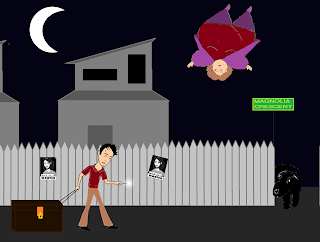Harry Potter and the Prisoner of Azkaban was published on July 8th, 1999. The book is decidedly less childish, and acts as a sort of transition between the wonderment-heavy first installments and the darker, more death-filled final four books. So, how does the book stack up to its predecessors, and how well does it act as the final layer of foundation for the series? Let’s look, shall we? Spoilers Ahead, obvs
(Click to Enlarge Photos)
 |
| People should be more worried about Marge. There's a Sirius Black loose. |
The book follows Harry as he embarks on his third year of schooling at Hogwarts School of Witchcraft and Wizardry. He gets off to a shaky start when he accidentally engorges his aunt (which causes her to float away) and flees the Dursleys. However, he’s forgiven for this
accidental ballooning because there’s a murderer on the loose, Sirius Black, and rumor has it that Black is after Harry. Apparently, Black escaped Azkaban (wizard prison, guarded by soul-sucking, cheerfulness-zapping Dementors) to find Harry to finish the job Voldemort couldn’t. However, as the year progresses, Harry realizes that maybe he should be the one searching for Black, due to Black’s involvement in the Potter murders that shape the series. Also, he learns to overcome his fears or something as he fights off the Dementors that have been posted at the school and who have taken a particular interest in our young protagonist.
accidental ballooning because there’s a murderer on the loose, Sirius Black, and rumor has it that Black is after Harry. Apparently, Black escaped Azkaban (wizard prison, guarded by soul-sucking, cheerfulness-zapping Dementors) to find Harry to finish the job Voldemort couldn’t. However, as the year progresses, Harry realizes that maybe he should be the one searching for Black, due to Black’s involvement in the Potter murders that shape the series. Also, he learns to overcome his fears or something as he fights off the Dementors that have been posted at the school and who have taken a particular interest in our young protagonist.
 |
| Yeah, Dementors love Harry |
It’s a doozy of a ride, filled with new teachers, Weeping Willows that Whomp, more insight into the life of James Potter, Time-Turners, pumpkin patches, wizard law, hippogriffs, and werewolves. It’s a thoroughly intense ride, and that alone make this the strongest book in the franchise thus far. Let’s break it down the book’s strengths and weaknesses, shall we?
 |
| Ladies and Gentleman: Professor Trelawney, and the best picture I've ever drawn |
One thing that J. K. Rowling does really well is introduce new characters and integrate them seamlessly into the narrative. She does this with new characters (Remus Lupin) who are supposed to be strangers, and she does it with new characters (Professor Sybil Trelawney) that are supposed to be well-known within the narrative. One of the ways she does this is by not overwhelming the reader and cramming every scene with information on the new characters. Lupin is a great character, and his journey in HP3 is integral to the plot, but he’s still only in less than a quarter of the book. Rowling lets him exist quietly, which makes him seem more real. Similarly, Trelawney, who is semi-important here (she really gets to shine in HP5), only shows up for five or six scenes in the entire novel. Rowling also accomplishes new character integration by downgrading some of the other characters. So, Seamus Finnigan, Dean Thomas, Neville Longbottom, and the Weasley twins get pushed to the side to make room. It's a cruel world.
There are a few things that start in this book that carry on throughout the book series. In the first few books, Harry is thrust into dangerous situations without much say on his part. Sure, he works out the clues and saves the day by putting himself and his friends into danger, but in the first books it seems like the only option. In this book, he is angry, and his search for justice is more dappled with vengeance than ever before. Even Professor McGonagall seems worried about him. Another thing explored in this book is his parent's history, most specifically the childhood and somerwhat dickish nature of James Potter. In many ways, this book series is about the imperfect nature of humanity. Characters that seem milky-white orbs of purity are tarnished and filled with shade of grey. Conversely, characters like Professor Snape are softened, their humanity creeping out behind their tough, black facade. You have time to do this sort of thing when there are seven books to complete a character's journey.
 |
| (L to R) Masters Moony, Wormtail, Padfoot, and Prongs |
So, how does the book stand up? Really well. It's by no means perfect. Rowling telegraphs her moves like four-hundred pages in advance. It's one thing to lay the groundwork for your story's big reveal, but Rowling writes so much about Hermione's schedule, Buckbeak the Hippogriff, and the Whomping Willow that it is pretty much a non-surprise when those things come into play. Also, lady loves a monologue, and we get so many in this book. In real life, nobody talks uninterrupted for that long unless they're giving a wedding speech or telling people the state of the union.
It's still really good, though.
Notables:
 |
| Cho Chang, chillin' |
- This is the only book where Voldemort does not appear in some fashion, which makes it more of a 'transition' book than any other in the series.
- Nobody/Nothing dies in this book, making it the only book where this is true (in Book 1 Professor Quirrell dies, in Book 2 the Basilisk is killed)
- J.K. Rowling has stated on numerous occasions that she had the easiest time HP3, as she had financial security to write in comfort and the obsessive Harry Potter uber-fanaticism hadn’t become so commonplace as to be distracting.
Movie 3 Review Coming Soon!